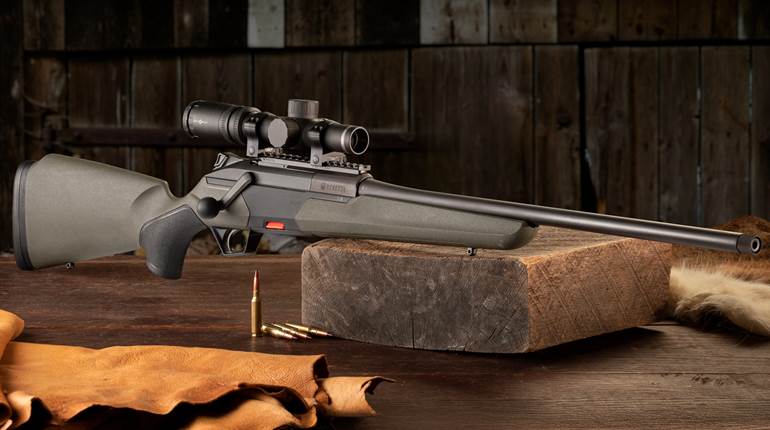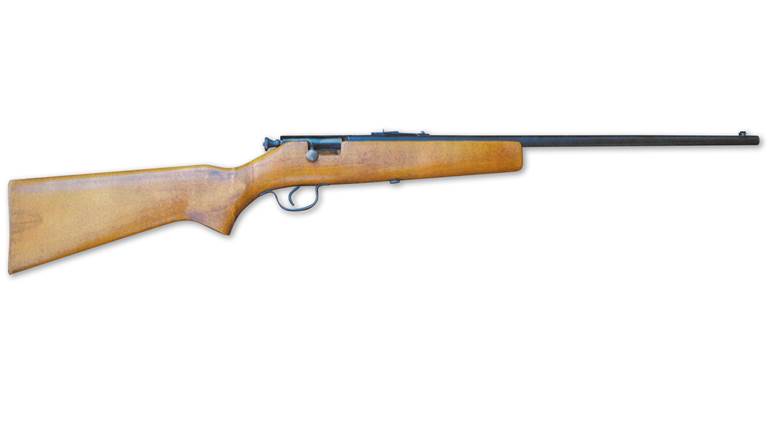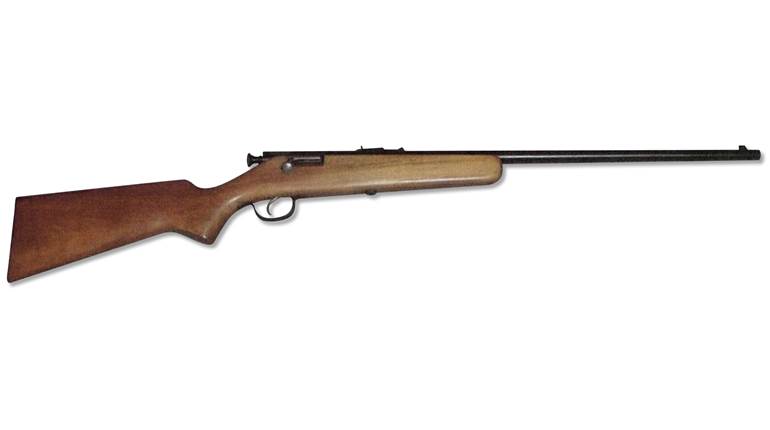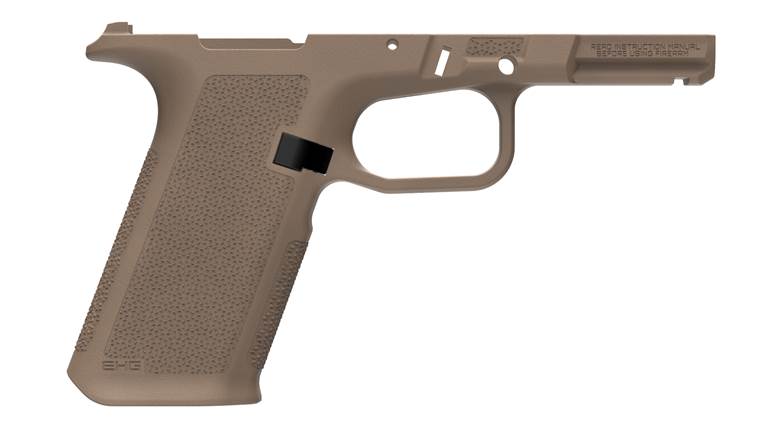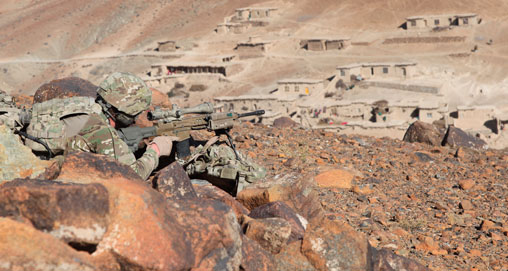
Nearly the size of Texas, Afghanistan’s expansive deserts, wide valleys and towering mountains offer seemingly unlimited visibility—visibility well beyond the effective range of America’s 5.56x45 mm NATO service rifles. Thus, the Taliban and Al-Qaeda usually avoid close-range engagements, preferring to fire at long range with mortars, heavy machine guns and RPGs, and then withdraw before U.S. artillery or close air support can respond. “Ninety-five percent of our firefights average 500 to 600 meters,” a veteran of Afghanistan recently told me, a figure supported by a U.S. Army study that found more than half of the war’s small arms engagements have been beyond 500 meters.
Understandably, then, thousands of M14s have come out of storage to be rebuilt and accurized by the U.S. Army and U.S. Marine Corps as Designated Marksman rifles. Topped with riflescopes, these updated 7.62x51 mm NATO rifles can be found in the hands of squad- and platoon-designated marksmen who support the soldiers and Marines around them. Fully qualified, school-trained snipers are found at battalion and higher levels, armed with purpose-built sniper rifles, mostly bolt-actions, but also some semi-automatics, all of them firing the 7.62x51 mm NATO cartridge. These snipers are tasked to support subordinate units, meaning that for the first time in U.S. military history, precision riflemen are assigned or attached at all levels of combat maneuver units.
The primary cartridge fired by these snipers and precision marksmen is the 7.62 mm, M118 Long Range, a 175-grain match load developed especially for sniping. Not only does the projectile experience one-third less wind drift than a 62-grain, 5.56 mm bullet, it delivers more than four times the energy at extended ranges. For instance, at 650 yards the M118LR packs as much energy—1,000 ft.-lbs.—as the 5.56 mm round at 100 yards. An Army sniper veteran of Afghanistan, Sgt. Jonathan Holmes, strongly favors the M118LR cartridge telling me it’s “accurate, dependable and hard-hitting.”
Long-Range Successes
American sniper teams go wherever U.S. infantrymen go, operating primarily in support of their fellow soldiers and Marines, usually from overwatch positions or by scouting to the front or flanks. Typically they engage enemy forces at 600 to 750 meters, where the Taliban like to hover, just beyond the range of 5.56 mm rifles.
These sniper teams also sometimes operate independently, whether lying in wait for terrorists planting improvised explosive devices (IEDs), searching for targets of opportunity, or acting on intelligence to intercept and ambush Taliban fighters. Such was the case for Sgt. Holmes, an 82nd Airborne Division sniper, when his team waited for a Taliban IED team in Kandahar Province. Eyeing several Taliban peering from a distant wadi, Holmes discerned which was in command and fired a single shot, dropping him at more than 700 yards. Intelligence later determined he had eliminated an enemy battalion commander and IED cell chief, for which Holmes was awarded the Army Commendation Medal.
Holmes also reports that suppressed sniper rifles have proven very effective at confusing and deceiving the enemy. During another operation he carried a suppressed M110 semi-automatic sniper rifle, also firing M118LR ammunition. Detecting three Taliban fighters across a river nearly 1,200 yards away, he fired one round that failed to connect. “The targets had no idea I fired the first round,” he recalled. His second shot struck the first Taliban, causing the other two to stand and look around, trying to determine where the shot had come from. That gave Holmes the chance to shoot a second Taliban, after which the third fighter fled. The young paratrooper eventually scored 10 enemy KIA with his suppressed rifle.
After Holmes and his fellow snipers utterly destroyed another IED team, U.S. radio monitors noted “chatter” in the form of pleas for Allah’s protection from the deadly American “Ghosts.” “I would say we struck fear in their hearts,” Holmes said.
The very effectiveness of American sniper teams has given rise to enemy counter-measures to detect and destroy them. In some areas the Taliban equip farmers and children with walkie-talkies and have them wander in search of hidden sniper teams, knowing the Americans would not harm such non-combatants. Once alerted, Taliban forces sneak in and plant IEDs or mines along the snipers’ likely withdrawal routes. Taliban fighters also sometimes swarm sniper teams.
That’s what happened to a U.S. Army National Guard sniper team that was supporting a 10-man U.S. Army Special Forces team. With no warning, some 50 Taliban suddenly opened fire, attempting to rush the snipers and Green Berets. However, the Americans maintained their composure, beating off the attack with well-aimed shots, killing 20 enemy. “They just kept coming and coming and coming,” reported one sniper, S/Sgt. Jason Fincher. The three snipers—S/Sgt. Fincher, Sgt. Anthony Sandoval and PFC Justo Baltasar—were each awarded the Bronze Star for Valor.
Afghanistan Sniper Foes
Afghans are renowned for excellent fieldcraft, displaying a native cunning that twice repelled British invaders in the 19th century and more recently defeated the Soviet Red Army. “Their [snipers’] accuracy wasn’t as impressive as their fieldcraft,” Army Spc. Garrett Taylor told the “New York Times.” “I mean, their ability to conceal themselves, distract us and displace to locations we didn’t expect.”
Although the 19th century Afghan tribesman’s long-barreled Jezail rifle—similar to the Kentucky longrifle—may have rained death upon past enemies, that marksmanship tradition has not continued into the 21st century. Canadian sniper Robert Furlong heard of Taliban snipers during his 2002 Afghan tour of duty, but no one he knew actually encountered any. Indeed, the rate of Americans lost to sniper fire in Afghanistan is dramatically lower than in Iraq. Why? Afghanistan suffers from one of the world’s worst illiteracy rates—some 57 percent of adult males cannot read or write, according to CIA figures. In this education vacuum, would-be snipers cannot master trajectory tables, ballistics, and a host of technical subjects required for effective long-range shooting. According to one British officer serving in Afghanistan, most enemy snipers simply, “fire and run,” and hope they hit something. As for enemy sniper armament, it runs the gamut from rusty old Lee-Enfield bolt-actions with open sights to scoped Russian SVDs and modern hunting rifles.
The quality of enemy snipers, however, is gradually improving. When U.S. forces advanced into the Taliban strongholds of Kandahar and Helmand Provinces in 2010, they were met with accurate rifle fire, especially during the Marine attack on the town of Marjah. Firing from “murder holes” punched through mud-brick walls, enemy snipers achieved a number of one-shot kills. USMC Lance Corporal Andrew Koenig took a sniper’s round directly into his helmet, just above his eyes. Knocked off his feet, he was otherwise uninjured. “Compared to last year,” he told a Reuters reporter, enemy snipers “seem to be much better.”
The best of these new shooters are thought to be foreign mercenaries—especially Chechens and Iraqi sniper veterans, plus volunteers from Egypt and Pakistan—drawn by bounties of tens of thousands of dollars for each killed American. The Taliban can certainly afford it; in 2007 the CIA estimates the Taliban made $300 million from heroin sales. As well, an Al-Qaeda sniper recruiting video is tapping into religious zeal, quoting the Koran: “Fight them and Allah will punish them by your hands, lay them low, and cover them with shame.” One Taliban commander claims a sniper training school already exists, its founding assisted by “Arab fighters, who have joined us.” There are many volunteers, he says.
Some enemy sniper teams have proven themselves dangerously effective. Two sniper teams—thought to be foreign mercenaries—roamed Hellmand Province for five months last year, killing and wounding British and American troops. Operating as two-man teams, they killed soldiers as far as 650 yards away, including four U.S. Marines and 10 Brits. The enemy snipers’ most amazing shot placed a round into a 9-inch parapet loophole to kill British soldier Darren Foster, aged 20. Another victim, a British sniper, was killed by a single shot to the head. During an 11-day period, elite British Special Air Service and U.S. Army Special Forces partnered to track down the two teams, finally cornering them in Hellmand Province’s Sangin Valley. In an anti-climatic finish, the barricaded enemy sniper teams were eliminated by precision bombs dropped by U.S. Air Force F-16s.
New Rifles, New Ammunition
It is with Afghanistan in mind that the U.S. is making significant advances in sniper rifles and long-range sniper ammunition. The Army’s 25-year-old M24 Sniper Weapon System, a .308-Win. rifle based on the Remington 700 action, is being replaced by a dramatically updated version, the XM2010, a Remington-built chassis rifle chambered for a new .300 Win. Mag. load. The new load, developed by Black Hills ammunition, pushes a 220-grain Sierra MatchKing bullet at 2,860 fps. Army tests found that the new load approximates the energy and accuracy of a .250-grain .338 Lapua Mag. load out to 1,500 yards, which is considered the new effective range for U.S. Army snipers.
This new .300 Win. Mag. load, the MK 248 MOD 1, also features a new propellant with an additive to reduce muzzle flash and a stabilized burn rate across a wide temperature range—from 25 below zero to 65 degrees F—a significant consideration for Afghanistan’s harsh climate and dramatic elevation variances. I’ve found that muzzle velocity can vary up to 300 fps due to the effect of extreme temperature changes on gunpowder.
However, the trusty old 7.62x51 mm NATO sniper round has not been forgotten. Its new load, developed at the Navy’s Crane Surface Warfare Center, incorporates a similar temperature-stabilized propellant and a muzzle-flash-reducing additive. Dubbed the Mk 316 MOD 0, the 175-grain load is being produced on contract by Federal Cartridge.
These new rifles and ammunition already are reaching the hands of American snipers in Afghanistan, where they’re being employed to regularly take out enemy forces at distances that were unheard of in World War II, Korea or Vietnam. Supported by state-of-the-art training and combat-experienced instructors, as demonstrated in Afghanistan, today’s generation of snipers is the finest and most capable we’ve ever fielded.













